Abstract
1. 2-Naphthylhydroxylamine and 2-nitrosonaphthalene were present in urine of dogs but not of guinea pigs, hamsters, rabbits or rats dosed with 2-naphthylamine. N-Acetyl-2-naphthylhydroxylamine and its O-sulphonic acid and O-glucosiduronic acid were not detected in the urine of any of these species. 2. Bile from rats dosed with 2-naphthylamine contained (2-naphthylamine N-glucosid)uronic acid and 6- and 5,6-substituted derivatives of 2-acetamidonaphthalene. 2-Amino-1-naphthyl and 2-acetamido-1-naphthyl derivatives, 2-naphthylhydroxylamine and its N-acetyl derivative or conjugates of these were not detected. Bile from a dog dosed with 2-naphthylamine contained no 2-amino-1-naphthyl derivatives. 3. 2-Naphthylhydroxylamine was metabolized by the dog, rat and guinea pig to the same products as those formed by these species from 2-naphthylamine. Rabbits formed mainly 2-amino-1-naphthyl derivatives; these are minor metabolites of 2-naphthylamine in this species. 4. (N-Acetyl-2-naphthylhydroxylamine O-glucosid)uronic acid was excreted in the urine and the bile of rats and in the urine of guinea pigs and rabbits dosed with N-acetyl-2-naphthylhydroxylamine. 5. After the administration of 2-acetamidonaphthalene, (N-acetyl-2-naphthylhydroxylamine O-glucosid)uronic acid was detected in the urine of dogs, but not in the urine of other species. The dog excreted an acid-labile cysteine derivative of 2-acetamidonaphthalene, but only traces of the corresponding mercapturic acid. 6. After dosing with N-acetyl-2-naphthylhydroxylamine-O-sulphonic acid, rats excreted derivatives of 2-amino-1-naphthol. 7. 2-Nitrosonaphthalene, N-acetyl-2-naphthylhydroxylamine, N-acetyl-2-naphthylhydroxylamine-O-sulphonic acid, 2-naphthylhydroxylamine-N-sulphonic acid, N-benzyloxycarbonyl-2-naphthylhydroxylamine and N-benzyloxycarbonyl-2-naphthylhydroxylamine-O-sulphonic acid were synthesized.
Full text
PDF
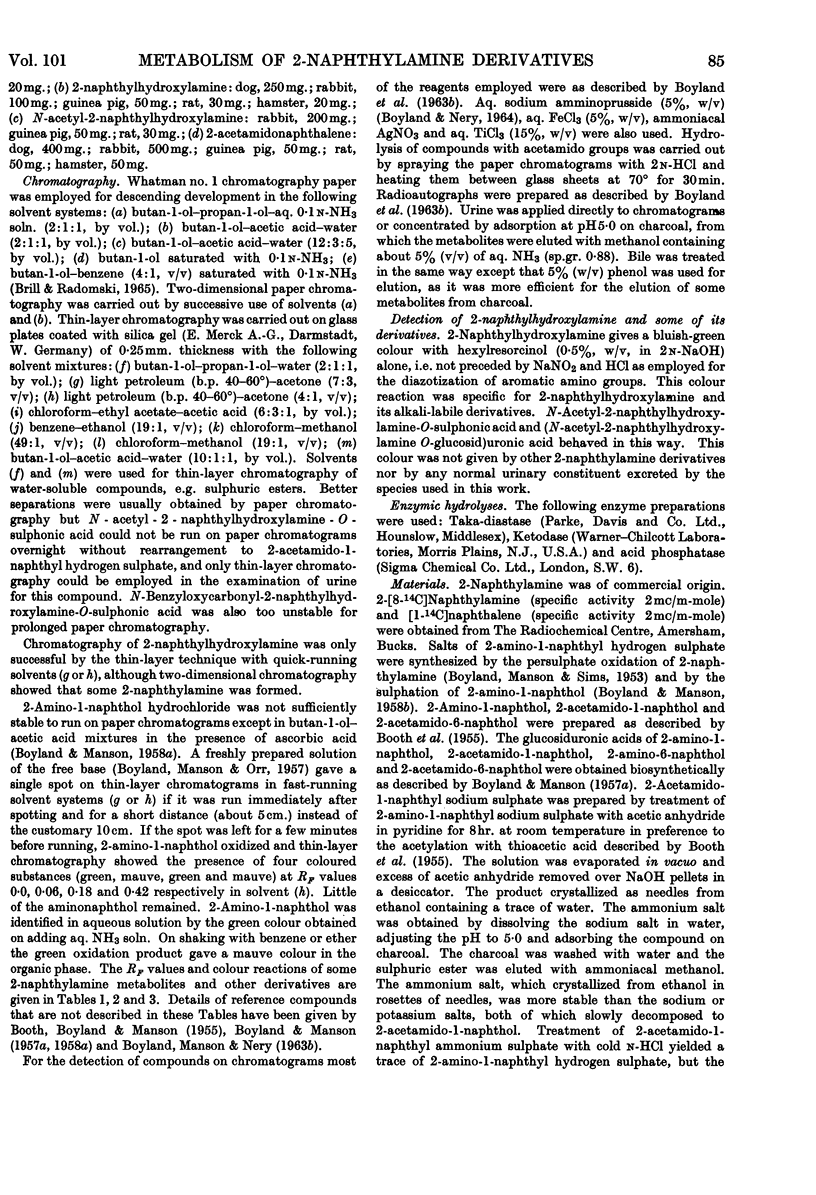
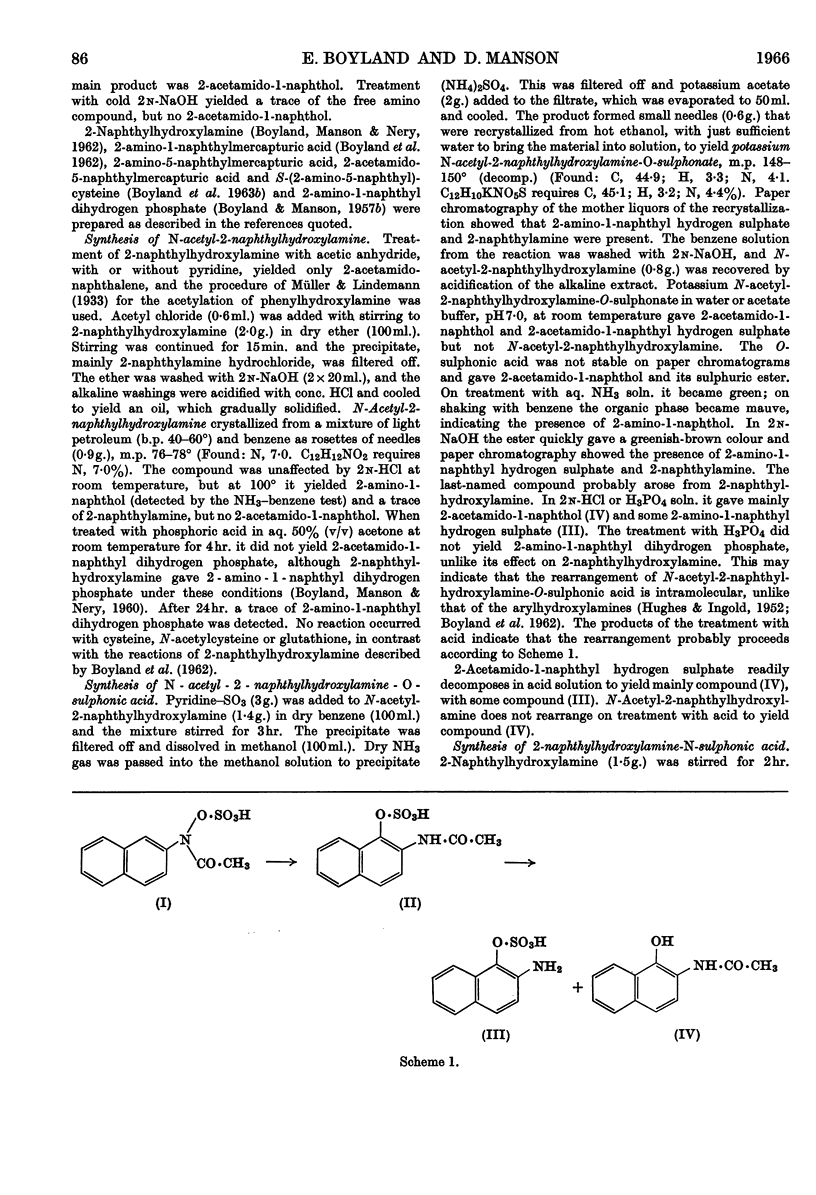

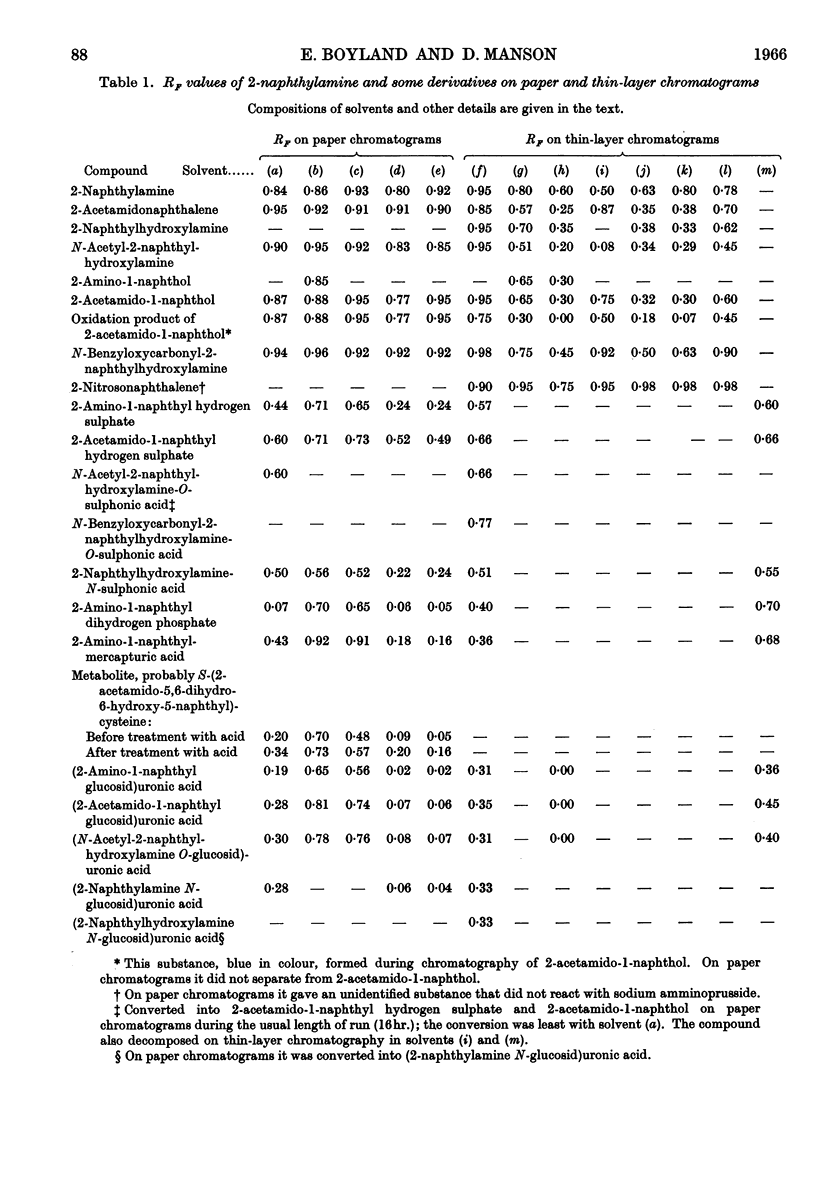
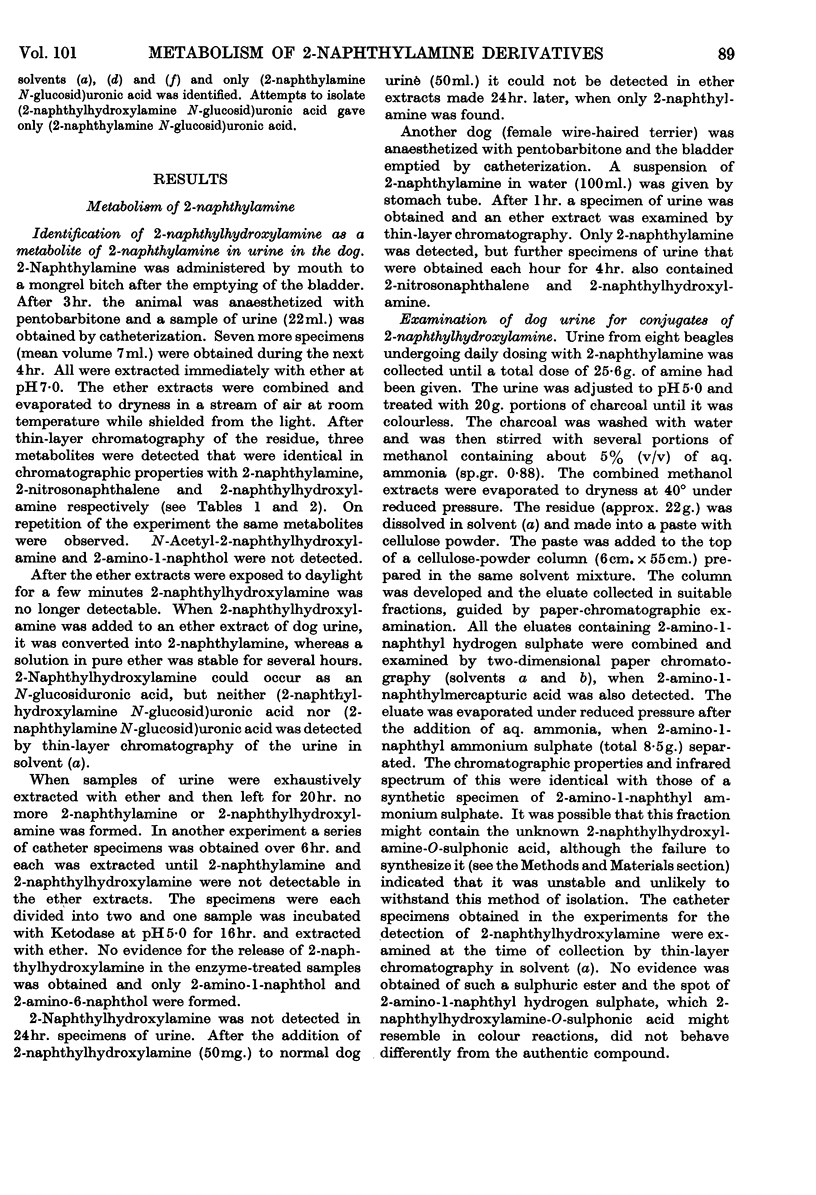
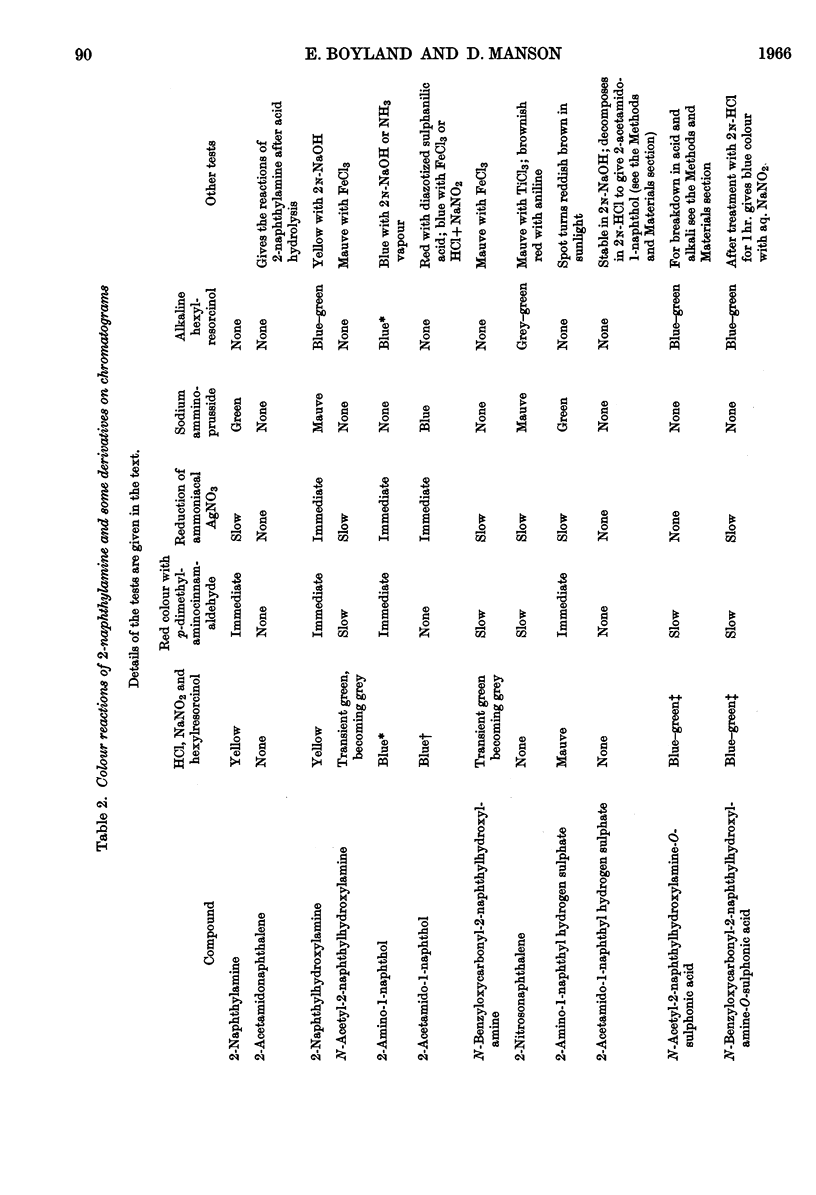
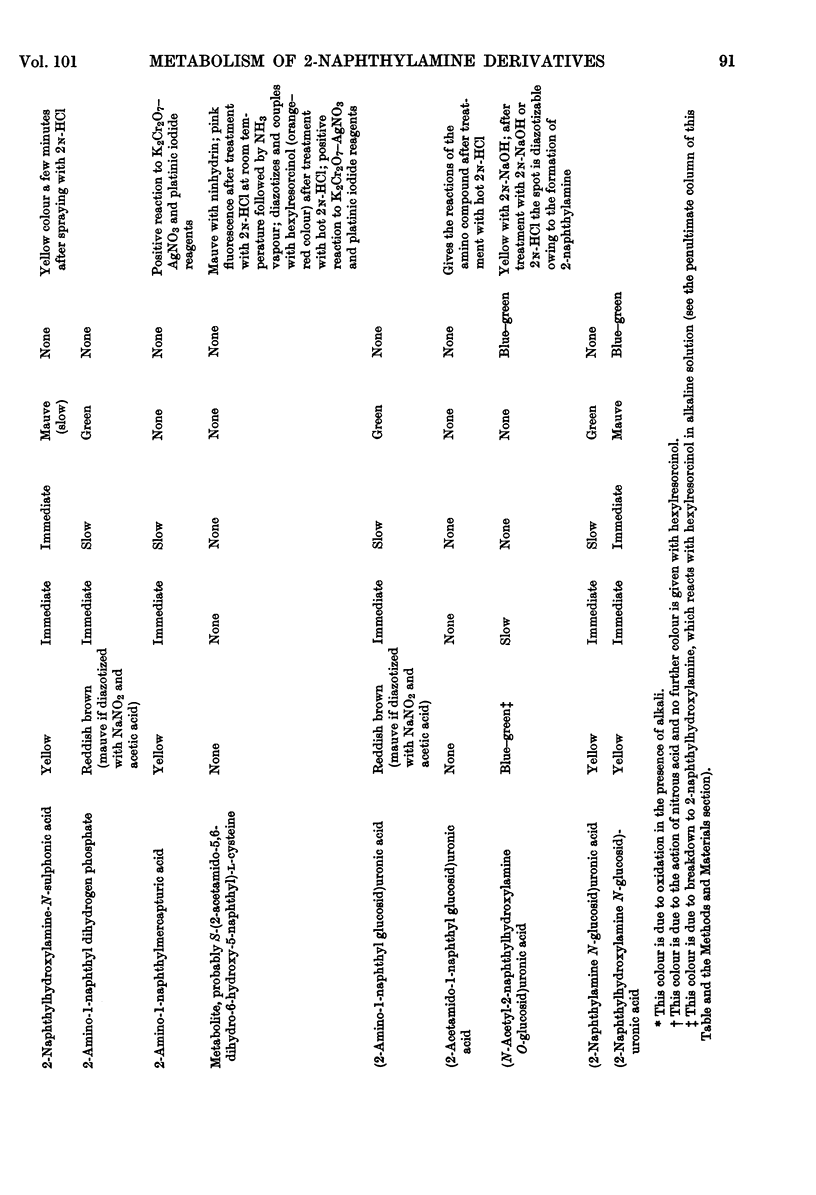


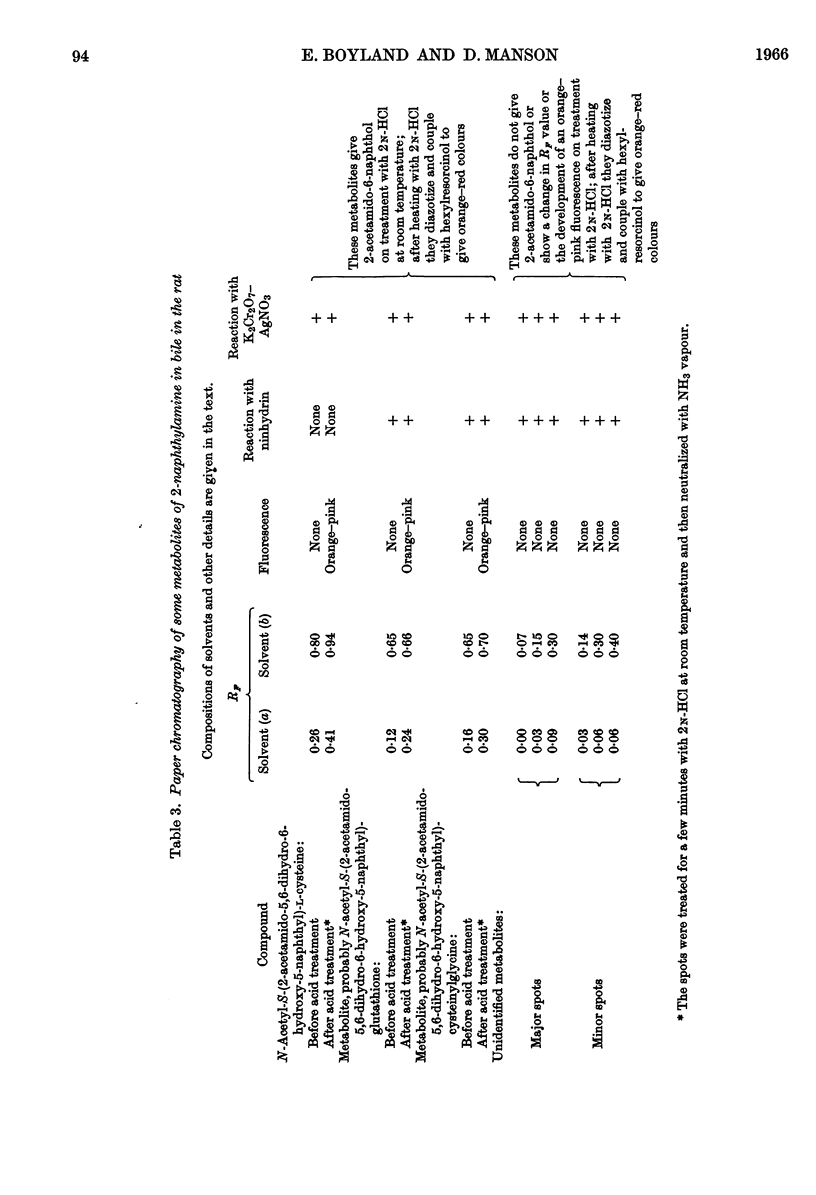
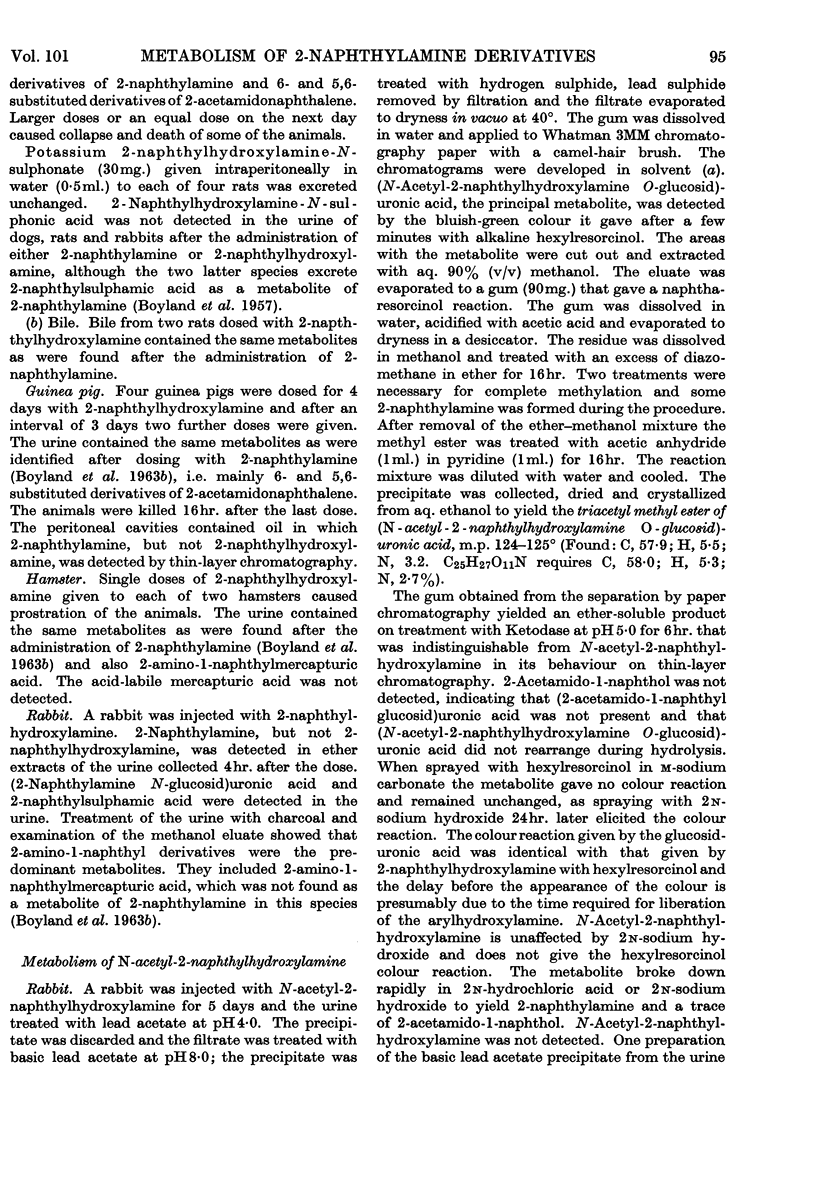

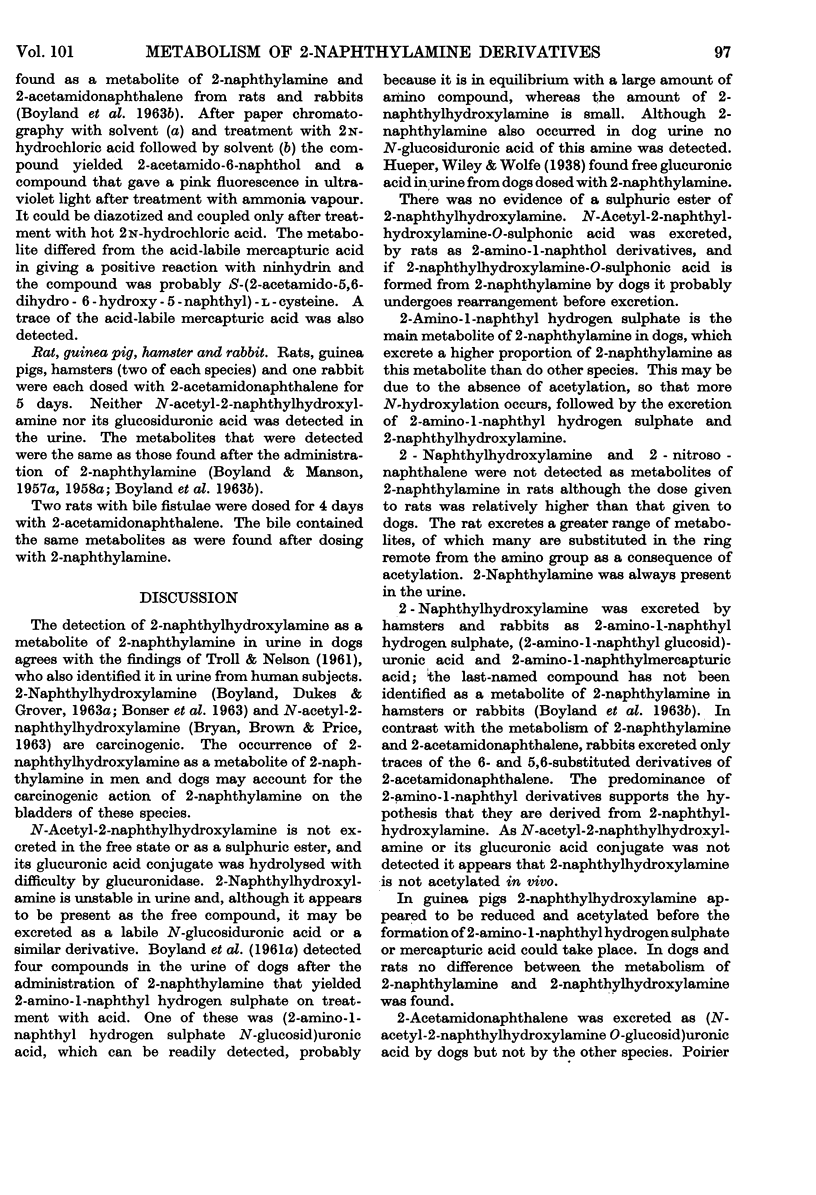
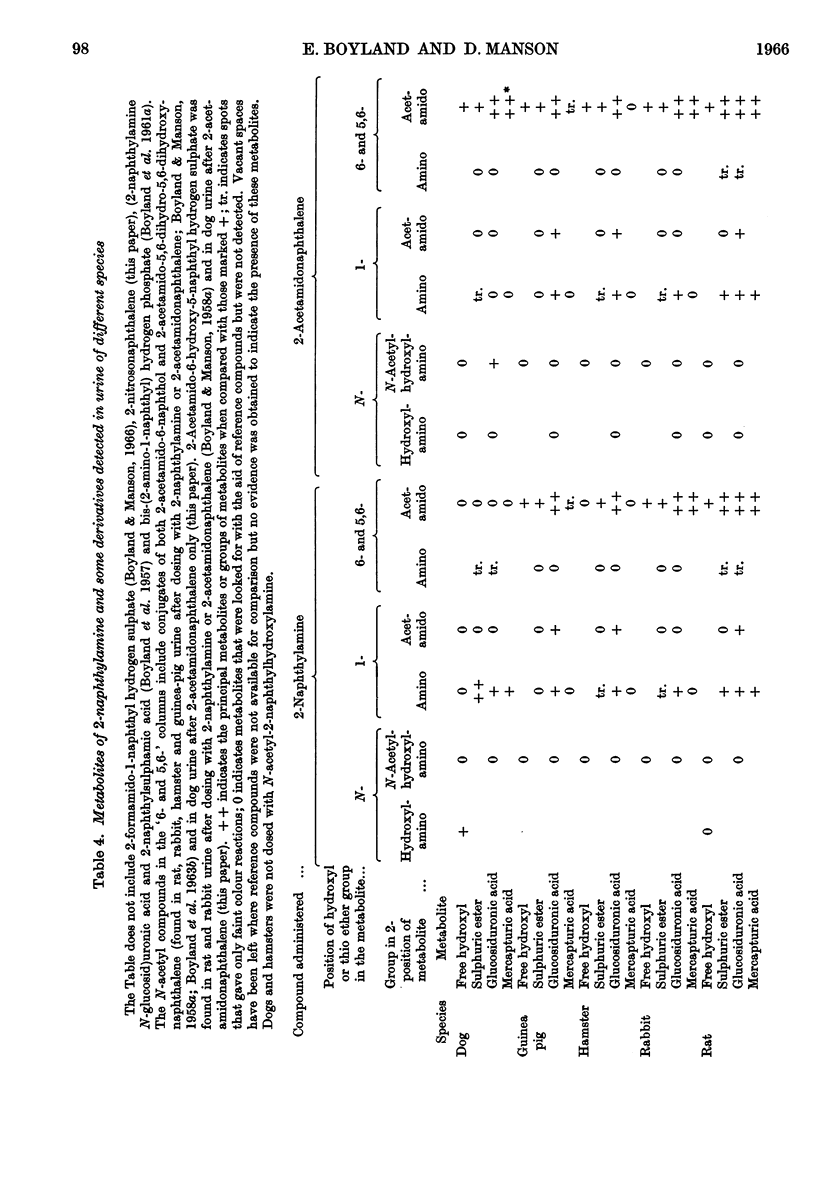


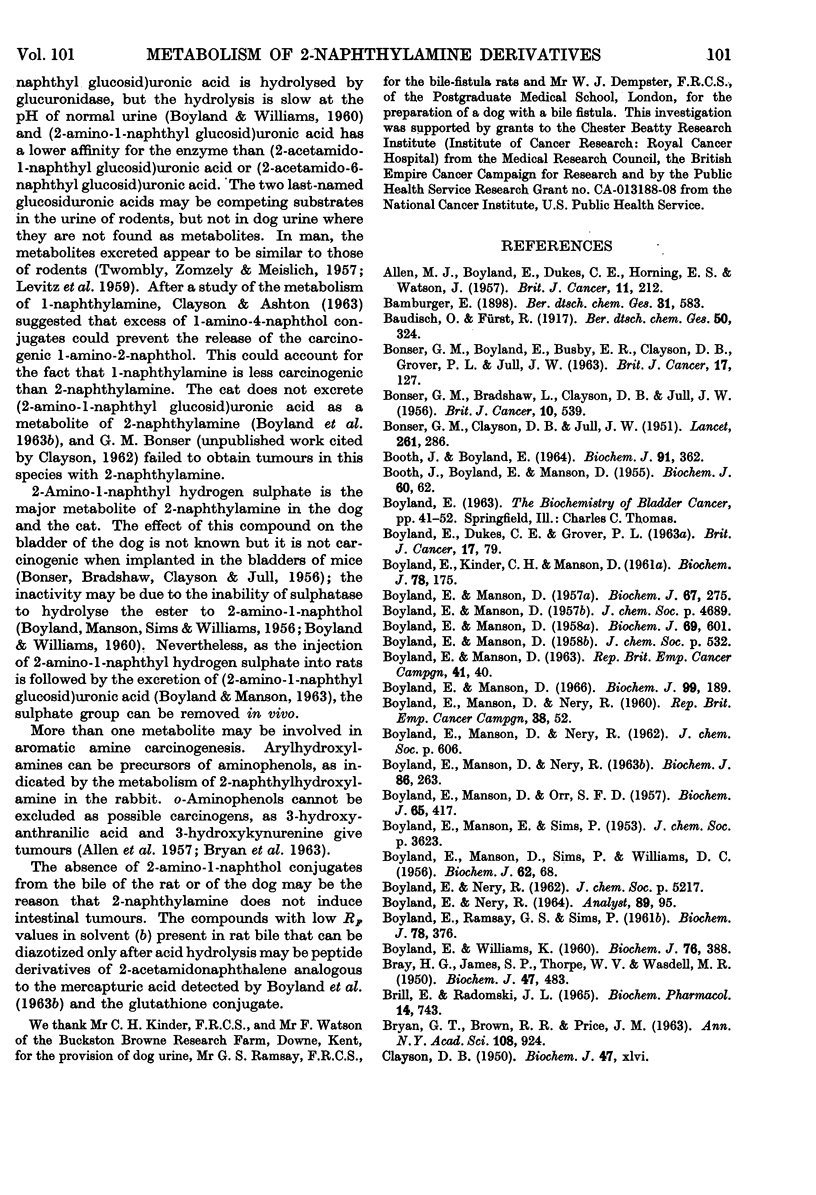

Selected References
These references are in PubMed. This may not be the complete list of references from this article.
- ALLEN M. J., BOYLAND E., DUKES C. E., HORNING E. S., WATSON J. G. Cancer of the urinary bladder induced in mice with metabolites of aromatic amines and tryptophan. Br J Cancer. 1957 Jun;11(2):212–228. doi: 10.1038/bjc.1957.29. [DOI] [PMC free article] [PubMed] [Google Scholar]
- BONSER G. M., BOYLAND E., BUSBY E. R., CLAYSON D. B., GROVER P. L., JULL J. W. A further study of bladder implantation in the mouse as a means of detecting carcinogenic activity: use of crushed paraffin wax or stearic acid as the vehicle. Br J Cancer. 1963 Mar;17:127–136. doi: 10.1038/bjc.1963.19. [DOI] [PMC free article] [PubMed] [Google Scholar]
- BONSER G. M., BRADSHAW L., CLAYSON D. B., JULL J. W. A further study of the carcinogenic properties of ortho hydroxy-amines and related compounds by bladder implantation in the mouse. Br J Cancer. 1956 Sep;10(3):539–546. doi: 10.1038/bjc.1956.63. [DOI] [PMC free article] [PubMed] [Google Scholar]
- BONSER G. M., CLAYSON D. B., JULL J. W. An experimental inquiry into the cause of industrial bladder cancer. Lancet. 1951 Aug 18;2(6677):286–288. doi: 10.1016/s0140-6736(51)93281-3. [DOI] [PubMed] [Google Scholar]
- BOOTH J., BOYLAND E., MANSON D. Metabolism of polycyclic compounds. 9. Metabolism of 2-naphthylamine in rat tissue slices. Biochem J. 1955 May;60(1):62–71. doi: 10.1042/bj0600062. [DOI] [PMC free article] [PubMed] [Google Scholar]
- BOYLAND E., DUKES C. E., GROVER P. L. Carcinogenicity of 2-naphthylhydroxylamine and 2-naphthylamine. Br J Cancer. 1963 Mar;17:79–84. doi: 10.1038/bjc.1963.12. [DOI] [PMC free article] [PubMed] [Google Scholar]
- BOYLAND E., MANSON D., NERY R. The biochemistry of aromatic amines. 9. Mercapturic acids as metabolites of aniline and 2-naphthylamine. Biochem J. 1963 Feb;86:263–271. doi: 10.1042/bj0860263. [DOI] [PMC free article] [PubMed] [Google Scholar]
- BOYLAND E., MANSON D., ORR S. F. The biochemistry of aromatic amines. II. The conversion of arylamines into arylsulphamic acids and arylamine-N-glucosiduronic acids. Biochem J. 1957 Mar;65(3):417–423. doi: 10.1042/bj0650417a. [DOI] [PMC free article] [PubMed] [Google Scholar]
- BOYLAND E., MANSON D., SIMS P., WILLIAMS D. C. The biochemistry of aromatic amines; the resistance of some o-aminoaryl sulphates to hydrolysis by aryl sulphatases. Biochem J. 1956 Jan;62(1):68–71. doi: 10.1042/bj0620068. [DOI] [PMC free article] [PubMed] [Google Scholar]
- BOYLAND E., MANSON D. The biochemistry of aromatic amines. 4. O-glucosiduronic acid derivatives of 2-naphthylamine. Biochem J. 1957 Oct;67(2):275–279. doi: 10.1042/bj0670275. [DOI] [PMC free article] [PubMed] [Google Scholar]
- BOYLAND E., MANSON D. The biochemistry of aromatic amines. 5. 2-Aceta-mido-6-hydroxy-5-naphthyl hydrogen sulphate and other metabolites of 2-naphthylamine and 2-aceta-midonaphthalene. Biochem J. 1958 Aug;69(4):601–605. doi: 10.1042/bj0690601. [DOI] [PMC free article] [PubMed] [Google Scholar]
- BOYLAND E., WILLIAMS K. The biochemistry of aromatic amines. 7. The enzymic hydrolysis of aminonaphthyl glucosiduronic acids. Biochem J. 1960 Aug;76:388–396. doi: 10.1042/bj0760388. [DOI] [PMC free article] [PubMed] [Google Scholar]
- BRAY H. G., JAMES S. P., THORPE W. V., WASDELL M. R. Deacetylation of acetamido compounds by tissue extracts. Biochem J. 1950 Oct;47(4):483–488. doi: 10.1042/bj0470483. [DOI] [PMC free article] [PubMed] [Google Scholar]
- BRYAN G. T., BROWN R. R., PRICE J. M. STUDIES ON THE ETIOLOGY OF BOVINE BLADDER CANCER. Ann N Y Acad Sci. 1963 Nov 4;108:924–937. doi: 10.1111/j.1749-6632.1963.tb13430.x. [DOI] [PubMed] [Google Scholar]
- Booth J., Boyland E. The biochemistry of aromatic amines. 10. Enzymic N-hydroxylation of arylamines and conversion of arylhydroxylamines into o-aminophenols. Biochem J. 1964 May;91(2):362–369. doi: 10.1042/bj0910362. [DOI] [PMC free article] [PubMed] [Google Scholar]
- Boyland E., Kinder C. H., Manson D. The biochemistry of aromatic amines. 8. Synthesis and detection of di-(2-amino-1-naphthyl) hydrogen phosphate, a metabolite of 2-naphthylamine in dogs. Biochem J. 1961 Jan;78(1):175–179. doi: 10.1042/bj0780175. [DOI] [PMC free article] [PubMed] [Google Scholar]
- Boyland E., Manson D. The biochemistry of aromatic amines. 2-Formamido-1-naphthyl hydrogen sulphate, a metabolite of 2-naphthylamine. Biochem J. 1966 Apr;99(1):189–199. doi: 10.1042/bj0990189. [DOI] [PMC free article] [PubMed] [Google Scholar]
- Boyland E., Ramsay G. S., Sims P. Metabolism of polycyclic compounds. 18. The secretion of metabolites of naphthalene, 1:2-dihydronaphthalene and 1:2-epoxy-1:2:3:4-tetrahydronaphthalene in rat bile. Biochem J. 1961 Feb;78(2):376–384. doi: 10.1042/bj0780376. [DOI] [PMC free article] [PubMed] [Google Scholar]
- Brill E., Radomski J. L. The role of hydroxyamines in bladder cancer. I. Fluorescence studies of the bladder mucosa of dogs fed 2-aminonapthalene. Biochem Pharmacol. 1965 May;14(5):743–752. doi: 10.1016/0006-2952(65)90092-4. [DOI] [PubMed] [Google Scholar]
- CLAYSON D. B., ASHTON M. J. THE METABOLISM OF 1-NAPHTHYLAMINE AND ITS BEARING ON THE MODE OF CARCINOGENESIS OF THE AROMATIC AMINES. Acta Unio Int Contra Cancrum. 1963;19:539–542. [PubMed] [Google Scholar]
- CRAMER J. W., MILLER J. A., MILLER E. C. N-Hydroxylation: A new metabolic reaction observed in the rat with the carcinogen 2-acetylaminofluorene. J Biol Chem. 1960 Mar;235:885–888. [PubMed] [Google Scholar]
- DEWHURST F. THE EFFECT OF AGE, SEX, STRAIN, SPECIES AND DOSE LEVEL DIFFERENCES UPON THE METABOLISM OF 2-NAPHTHYLAMINE IN RODENTS. Br J Cancer. 1963 Jun;17:365–370. doi: 10.1038/bjc.1963.50. [DOI] [PMC free article] [PubMed] [Google Scholar]
- HERINGLAKE R., KIESE M., RENNER G., WENZ W. [N-oxidation of 2-naphthylamine in vivo and the effects of the oxidation products of 2-naphthylamine]. Naunyn Schmiedebergs Arch Exp Pathol Pharmakol. 1960;239:370–382. [PubMed] [Google Scholar]
- POIRIER L. A., MILLER J. A., MILLER E. C. The N- and ring-hydroxylation of 2-acetylaminofluorene and the failure to detect N-acetylation of 2-aminofluorene in the dog. Cancer Res. 1963 Jun;23:790–800. [PubMed] [Google Scholar]
- TROLL W., BELMAN S., NELSON N. Aromatic amines. III. Note on bis (2-amino-1-naphthyl) phosphate, a urinary metabolite of 2-naphthylamine. Proc Soc Exp Biol Med. 1959 Jan;100(1):121–122. doi: 10.3181/00379727-100-24544. [DOI] [PubMed] [Google Scholar]
- TROLL W., TESSLER A. N., NELSON N. Bis (2-amino-1-naphthyl) phosphate, a metabolite of beta-naphthylamine in human urine. J Urol. 1963 Apr;89:626–627. doi: 10.1016/S0022-5347(17)64607-X. [DOI] [PubMed] [Google Scholar]
- WEISBURGER J. H., GRANTHAM P. H., VANHORN E., STEIGBIGEL N. H., RALL D. P., WEISBURGER E. K. ACTIVATION AND DETOXIFICATION OF N-2-FLUORENYLACETAMIDE IN MAN. Cancer Res. 1964 Apr;24:475–479. [PubMed] [Google Scholar]


